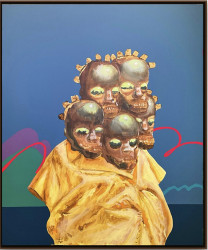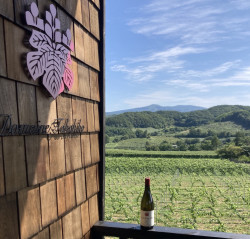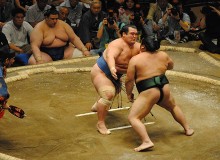
June 17, 2010
Kenka & Hatabi no Dahlia
Torifune butoh company debuts a new work and reprises a classic
By Metropolis
Originally published on metropolis.co.jp on June 2010

Photo by Masahiko Taniguchi
The avant-garde dance form of butoh was inspired by Western modern dance, but its founders also looked closer to home, absorbing the influence of traditional performing arts like noh and even the movements of peasants in rice paddies. In some ways, it still adheres to the clan lineages of classic Japanese arts—for instance, connection to a master is all-important. Which helps explain why Kayo Minami, a disciple of butoh founder Tatsumi Hijikata, is one of the country’s most revered dancers.
Next month, Minami will reprise the classic work Kenka (“Consecration of Flowers”), while younger members of her Torifune Butoh Sha troupe will present Hatabi no Dahlia (“Dahlia on Flag Day”), the latest in a series inspired by the tough Kandachime horses of Japan’s cold northern regions.
Performed in 23 cities worldwide since its debut two decades ago, Kenka is considered one of the defining works of butoh to be staged since Hijikata’s death, with all of the form’s subtlety and emotional violence contained in its 80 minutes. A solo piece featuring Mikami, it is based on the suicide of a friend who slit her throat in front of her children.
Mikami’s husband Yukio, who is also the director of Torifune Butoh Sha, says the troupe is reviving the work in response to audience demand. “Kenka is popular, particularly with women—it seems to touch them deeply, and there are many who cry when they see it. The theme is sad, yet it’s not an entirely sad work. It’s about all the people we have met and will meet in life and is a tribute to them.”
Hatabi no Dahlia is the sixth in the Kandachime series, created for the younger members among Torifune’s corps. Ten dancers perform to music by J.A. Ceasar, an iconic composer in Japanese avant-garde performing arts since the ’70s.
Mikami stresses the message of resilience conveyed by the small Kandachime horses that inhabit northern Tohoku, the same region where Hijikata and Mikami himself were born. “The stereotype of the area is gloomy, but in fact the people of Tohoku are optimistic,” he says. “Because the region is poor and many young people come to Tokyo for work, and because their accent is incomprehensible and many aren’t educated, they developed a dark image. But they are in fact a resourceful and cheerful people who like to dance.”
Mikami says there is a similar misunderstanding about butoh, which is famed for its dancers’ white body paint and slow, tortured movements—a performer may take 30 minutes just to move a few meters. “Butoh is sometimes called ‘ankoku butoh’ [“dance of darkness”], but it’s the darkness of a cheerful region. The idea is that even within darkness, there is optimism.
“Ankoku also means ‘hell,’ and hell may actually be a pretty fun place,” he continues with a laugh. “At the least, our butoh at Torifune is a cheerful dance of darkness.” Rather than the finely sculpted youth who populate other companies, Torifune is known for dancers of all ages, many of whom attend its weekly workshops in Enoshima.
Mikami discounts suggestions that the butoh movement has run its course—a view made all the more poignant by the death two weeks ago of butoh co-founder Kazuo Ohno.
“People have been saying that butoh is finished for a long time, but it only seems to grow in strength,” he says. “Maybe it’s because other Japanese performing arts are stunted by the producer system, in which only big TV stars like SMAP can sustain a show. They want to see Kimutaku on stage, but that’s getting boring for a lot of people. We may be reaching a turning point for Japanese performing arts—our audience is increasing.”
Kenka & Hatabi no Dahlia
July 16-17, ¥2,500 (student, adv)/¥3,000 (student, door)/¥3,000 (adult, adv)/¥3,500 (adult, door). Theater X, Ryogoku. Tel: 0463-60-1008. http://w01.tp1.jp/~a150397531/







